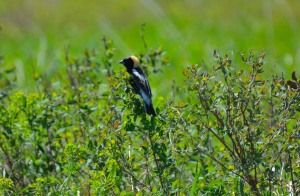Before we get to the blog post, I just wanted to get a quick shout out to Char Binstock. If you did not know Char has stepped down from her seat as president of the Bismarck-Mandan Birding Club. I would like to say thanks to her for getting this group up and running again. Though the start seems a bit slow, we have progressed into trying to provide some activities and try to get resources running smoothly. Thanks again Char, I do not think the club would be able to start off again if it was not for you and knowing new people to going and starting the old group up again.
Now back to the post. Now that birds seem to be everywhere again and as the leaves on trees have developed, woodland birds are coming harder to see. But as we know of North Dakota, is more known as a prairie state. One species, the Bobolink, has returned to the grasslands and prairies of North Dakota. They can be seen perched on grass stems or seen displaying over open fields as the males return to the nest territory before their female counterpart. These little birds are quite impressive as they are some of the farthest traveling birds over their migration routes. They migrate to southern areas of South American, which can be over 6,000 miles of flying. Males of these birds are easy to identify with their white back and black underparts, or how some described as wearing a tuxedo backward. To go with their “Tuxedos” is the males yellow patch on the back of his head. It’s important to remember that North Dakota is a prairie state as these with other grassland birds have started to decline over the years due to turning over areas of grass for development and crop production. These birds are known as indicator species, since they are not shy about showing themselves, to see how healthy grasslands are. If the bobolink disappears, other grassland birds are sure to be not far behind.
Other Facts
- The species name of the Bobolink, oryzivorusmeans “rice-eating” and refers to this bird’s appetite for rice and other grains, especially during migration and in winter.
- A migrating Bobolink can orient itself with the earth’s magnetic field, thanks to iron oxide in bristles of its nasal cavity and in tissues around the olfactory bulb and nerve. Bobolinks also use the starry night sky to guide their travels.
- On migration, many of these birds fly to Florida. Normally a daylight forager, they sometimes feed after dark on bright nights during migration, to build fat reserves for its long flight over the Gulf of Mexico to South America.


